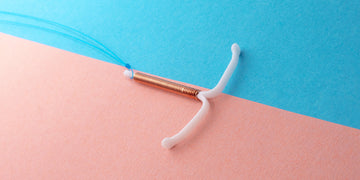3 things to know when choosing an IUD

Today, there are several different options of birth control: contraception pills, condoms, and even patches. There are a few different options that are classified as ‘Long Acting Reversible Contraception’ or LARCs, such as an implant or IUD, which can be a practical long-term choice. Many opt for IUDs since they can be a convenient option for preventing pregnancy and regulating periods.
IUD stands for an intrauterine device, as this device is inserted and removed from your uterus by your primary care provider or OBGYN. Another type of LARC is an implant (like a Nexplanon) that is placed in your upper arm and stays in for a few years, which some find convenient. Depending on the device and recommendations from your primary care provider, they can stay in your body anywhere from 3 to 12 years.
If you are thinking about getting an IUD, there are a few things you should consider:
- Types of IUDs
- Side effects of IUDs
- Replacement times
Types of IUDs
There are two different types of IUDs: hormonal and non-hormonal (made with copper). Both prevent pregnancy, but have different ways in which they work.
Copper IUD (Paragard)
A copper IUD does not use hormones as a method of birth control. Instead, they are wrapped in small copper wire and rely on the chemical properties of copper to provide a form of birth control. Copper works by making the uterus an unfavorable environment for sperm quality and motility, making it harder to get to the ovaries. Once placed, this IUD can stay in for up to 10 years before having to have it taken out and replaced, or removed all together.
In addition, they have a 99.2% efficacy rate, which means that for every 1,000 people, only 8 people may have an unintended pregnancy. Copper IUD’s can be used for emergency contraception (preventing pregnancy after having sexual intercourse) if placed within 5 days.
Hormonal IUD
Hormonal IUDs contain a small amount of progesterone that is released directly into your reproductive system. This will then cause the mucus in the uterus to thicken, preventing the sperm from being able to migrate to meet the egg. Though hormonal IUDs rely on progesterone, it is important to note that they can contain less hormones as the standard oral contraceptive pill.
They are 99.8% effective, which means that for every 1000 people, only 2 will have an unintentional pregnancy. In addition, many people may choose to use hormonal IUDs to help treat their symptoms of endometriosis and PCOS. Depending on how long you would like the IUD in place, hormonal IUD’s can stay in place for 3, 5, or 7 years. You also have the option to have it removed at any time.
Shop the article
Side effects of IUDs
Depending on whether you have a hormonal or non-hormonal IUD, the side effects you experience may differ.
Hormonal IUD side effects
Those with hormonal IUDs may experience some side effects. Some of the side effects will go away within a few days, others may last 3-4 months, but will gradually get better as your body adjusts to the IUD. You may also experience pain during insertion, cramping, and backaches for a few days afterward. The most common side effects of hormonal IUDs are:
- Lighter periods
- No periods (this is normal and safe)
- Spotting between periods
- Irregular periods
Copper IUD side effects
With copper IUDs, you may still experience side effects that differ from side effects typically common with hormonal IUDs. You may experience more bleeding and cramping during your periods following copper IUD placement, but these symptoms typically go away between 3 to 6 months after insertion. Common side effects of copper IUDs are:
- Spotting between periods
- Irregular periods
- Heavier or longer periods
- Cramping may be worse during periods
Discuss potential side effects with your primary physician to help determine which IUD is best for you. If you experience bleeding or pain that doesn't get better or is worse than usual after you have an IUD placed, contact your primary care provider to speak with a nurse right away. There is a chance that your IUD is out of place and may need to be examined.
Once you have determined which type of IUD you’d like to have, you should then consider how long you’d like to have your IUD, then schedule an appointment with your primary care provider or OBGYN to discuss your options.
When should I replace my IUD?
Each IUD has specific guidelines on when it should be removed and replaced. Chat with your primary care provider about these timelines to determine what you feel comfortable with.
Here’s how long each type of IUD lasts:
- Skyla (hormonal): up to 3 years
- Kyleena (hormonal): up to 5 years
- Liletta (hormonal): up to 7 years
- Mirena (hormonal): up to 7 years
- Paragard (copper): up to 12 years
Your IUD will be removed by a doctor, and you shouldn’t feel any adverse effects upon removal. There may be slight bleeding or cramping, but this is entirely normal. Any side effects you may have experienced while using an IUD will eventually go away unless replaced.
Should you wait longer than the recommended time for removing your IUD, there is a chance that you may become pregnant as the IUD becomes less effective past the removal date, or experience a severe infection, which could lead to infertility.
IUDs provide a longer-lasting form of birth control that people can use to help treat PCOS, endometriosis, and other menstrual disorders. With varying replacement times, many are able to enjoy multiple years while on birth control without worrying about taking daily pills. As always, consult with your primary care physician to discuss your options and help you determine what’s possible for your body.
Have questions? Reach out athi@hellowinx.com for more info.
Keep Reading

Can you get pregnant with an IUD?
Dec 3

Should I tell my doctor I’m switching birth control?
Dec 27

How to find the birth control that works best for you
Jul 30











